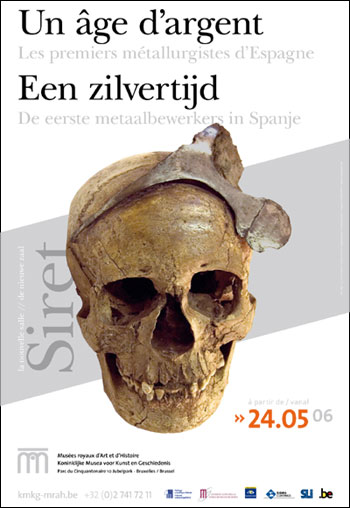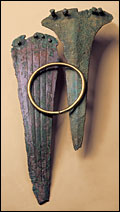As of the 4th millennium before our era, mediterranean Spain becomes a place of innovations and intense activity. The region is bountiful with ores of all types. Their exploitation entaîls major social, cultural and economic developments. Between 1880 and 1887, two Belgian geologists, brothers Louis and Henri Siret, mining engineers who worked in the province of Almería, carried out a great number of archeologic diggings, to discover not only an ensemble of very high quality objects, but most of the documents that illustrated the first metallurgic industry in Western Europe. Ever since, this discovery is known worldwide as the civilization of El Argar. The new Siret room that will be part from now on of the permanent exhibitions of the Musées royaux d’Art et d’Histoire, present all he wealth of this culture.
To die at El Argar
At the end of the 5th millennium, one could note, in the South-Eastern part of Spain, the presence of large tumbs, more or less circular. And in these collective graves, next to the lithic tools ( particularly arrow heads), one can find «idols» in the shape of violons, simple cut out stone sheets, which for a long time made everyone think of the influence of the cyclades. In the El Argar culture the collective graves disappeared and were replaced by individual ones, built under the walls of the houses. The personal property was distributed in a rather strict manner, according to the sex. Halberds, axes and spears were exclusively given to the men; the diadems to the women. It is also in the masculin graves one finds the greatest quantity of gold, of daggers and of careened vases. The women on the other hand receiced the greatest quantity of awls and jewels.
Costumes at the Bronze Age
Henri and Louis Siret gathered together recipients found at El Argar thus forming an ensemble of more than 300 pieces, but the most spectacular elements left to the dead in the culture of El Argar are certainly the silver diadems which many women were decorated with. Either as a simple thread around the head or as a embossed leaf, these diadems could also be decorated on the front with an appendix in a pear form, pointing either upwards or downwards. Necklaces are seen frequently. The grains were in earthenware, in stone, in bone, in ivory, in shell and even made from fruit pits. Sometimes a few elements in gold, silver or copper complete the jewel, reserved almost exclusively to the women. The bracelets, in copper or in silver, very rarely in gold, are both feminin and masculln. A few rings in silver were aso discovered.
The only «Silver Age » Spain has ever known
Iberia produced the oldest traces of copper industry currently known in Western Europe. We can find in the necropolis of El Argar a multitude of copper objects: daggers, spears, halberds. The use of bronze only appeared sporadically. Silver brought prosperity to the South-Eastern region of Spain at the beginning of the Bronze age. One can even notice the use of silver rivets to set the copper halberds or the daggers to their handle... After a period in which the region’s metallurgic industry was the spearhead of progress, it stagnated in the use of arsenic copper, even though it was out of fashion everywhe else in the Mediterranean basin, and had benn replaced by bronze. Silver would be the new vector of wealth. It was bountiful in the South-Eastern part of the Iberian Peninsula, where in fact it was exploited until not too long ago. El Argar is undoubtedly the only «silver Age» Europe ever had.
Illustration : Halberds in copper and gold bracelet, civilization of El Argar (Bronze Age), 3rd millennium
|









